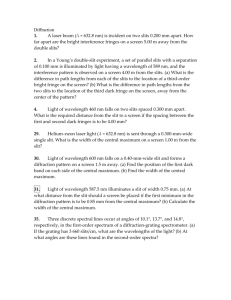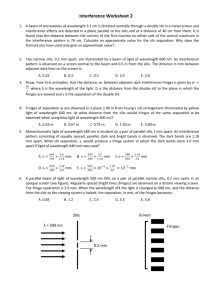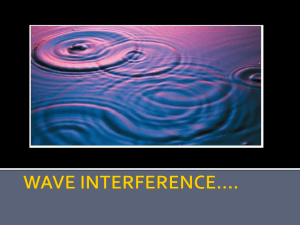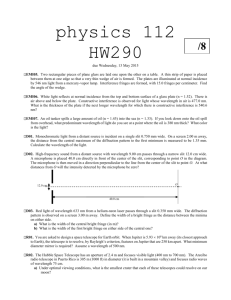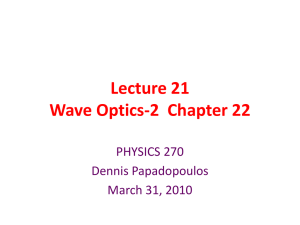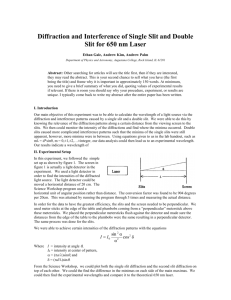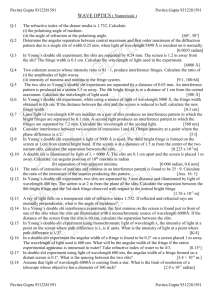If two waves have the same frequency and wavelength, and a constant
advertisement
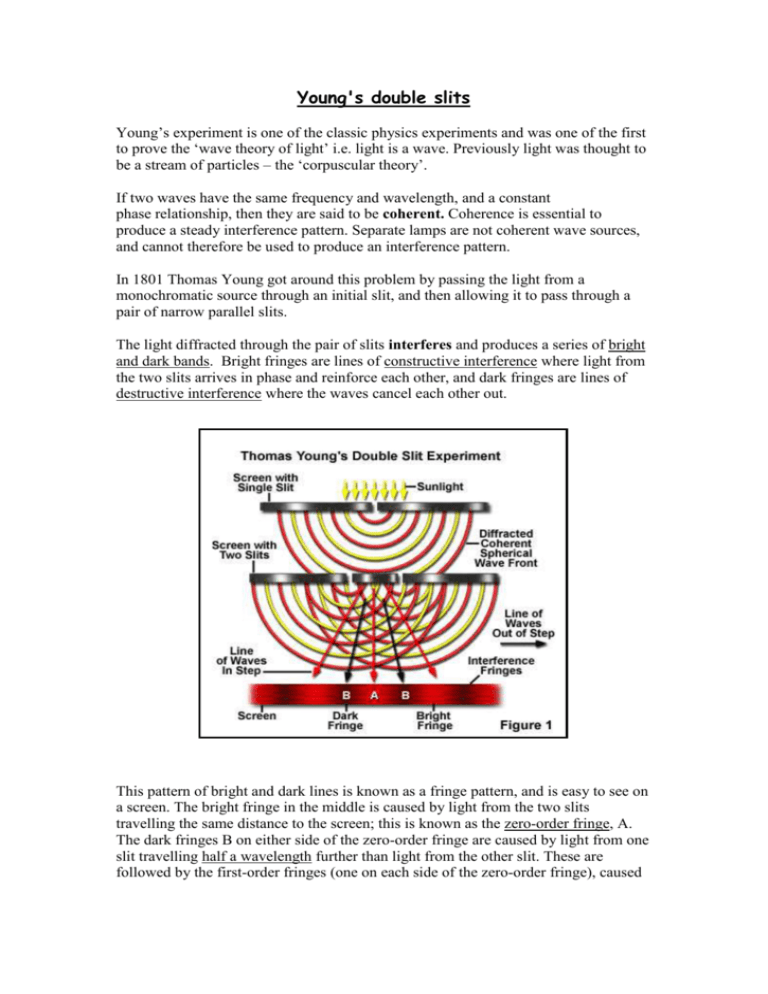
Young's double slits Young’s experiment is one of the classic physics experiments and was one of the first to prove the ‘wave theory of light’ i.e. light is a wave. Previously light was thought to be a stream of particles – the ‘corpuscular theory’. If two waves have the same frequency and wavelength, and a constant phase relationship, then they are said to be coherent. Coherence is essential to produce a steady interference pattern. Separate lamps are not coherent wave sources, and cannot therefore be used to produce an interference pattern. In 1801 Thomas Young got around this problem by passing the light from a monochromatic source through an initial slit, and then allowing it to pass through a pair of narrow parallel slits. The light diffracted through the pair of slits interferes and produces a series of bright and dark bands. Bright fringes are lines of constructive interference where light from the two slits arrives in phase and reinforce each other, and dark fringes are lines of destructive interference where the waves cancel each other out. This pattern of bright and dark lines is known as a fringe pattern, and is easy to see on a screen. The bright fringe in the middle is caused by light from the two slits travelling the same distance to the screen; this is known as the zero-order fringe, A. The dark fringes B on either side of the zero-order fringe are caused by light from one slit travelling half a wavelength further than light from the other slit. These are followed by the first-order fringes (one on each side of the zero-order fringe), caused by light from one slit travelling a wavelength further than light from the other slit, and so on. The diagram above shows the geometry for the fringe pattern. For two slits separated by a distance d, and emitting light at a particular wavelength, light will constructively interfere at certain angles. These angles are found by applying the condition for constructive interference, which in this case becomes: The angles at which dark fringes occur can be found be applying the condition for destructive interference: The Young Equation is usually written as: λ = ay / D where λ = wavelength of light a = slit separation y = fringe separation of adjacent bright or dark fringes D = slit to screen distance Note: Factors which affect the fringe separation. (i) (ii) (iii) (iv) Increasing D increases the fringe separation Decreasing a increases the fringe separation Increasing the slit width produces a more intense but a more blurred pattern Moving the source closer to the slits increases the intensity of the pattern but has no effect on the separation. Thomas Young was a not only a physicist but also a physician and Egyptologist, who was responsible for deciphering the Rosetta stone. Diffraction Grating When there is a need to separate light of different wavelengths with high resolution, then a diffraction grating is most often the tool of choice. This "super prism" aspect of the diffraction grating leads to application for measuring atomic spectra in both laboratory instruments and telescopes. A large number of parallel, closely spaced slits constitute a diffraction grating. The condition for maximum intensity is the same as that for the double slit or multiple slits, but with a large number of slits the intensity maximum is very sharp and narrow, providing the high resolution for spectroscopic applications. The peak intensities are also much higher for the grating than for the double slit. When light of a single wavelength, like the 632.8nm red light from a helium-neon laser at left, strikes a diffraction grating it is diffracted to each side in multiple orders. Orders 1 and 2 are shown to each side of the direct beam. Different wavelengths are diffracted at different angles, according to the grating relationship Remember the equation ! WJEC uses the following notation: nλ = d sin Ө Web sites. Single slit applet: http://webphysics.ph.msstate.edu/javamirror/ipmj/java/slitdiffr/index.html Young’s slit notes: http://hyperphysics.phy-astr.gsu.edu/hbase/hframe.html http://www.eiu.edu/~mediasrv/davis/chapter_20/ch20_2.htm http://tonydude.net/physics197/phys197.html Theory of slits: http://www.jcphysics.com/toolbox_indiv.php?page=27 Slit diffraction paterns: http://hyperphysics.phy-astr.gsu.edu/hbase/hframe.html http://online.cctt.org/physicslab/content/PhyAPB/lessonnotes/twosourceinterference/d oubleslitinterference.asp Applets at: http://physics.uwstout.edu/physapplets/Northwesten/www.physics.nwu.edu/vpl/optics /diffraction.html http://micro.magnet.fsu.edu/primer/java/doubleslitwavefronts/ http://www.colorado.edu/physics/2000/schroedinger/two-slit2.html Information on light phenomenon: http://www.exploratorium.edu/xref/phenomena/interference.html

